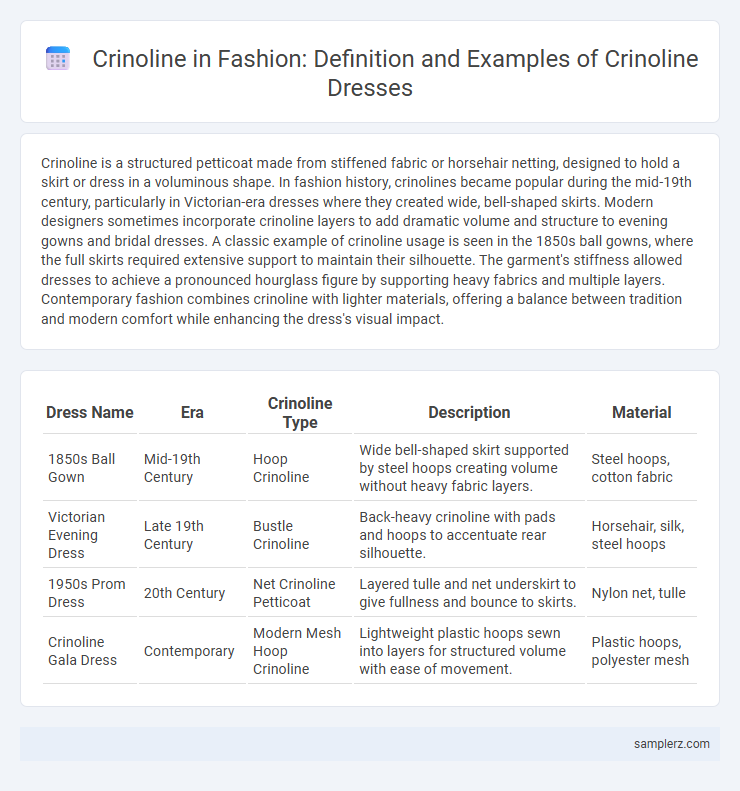Crinoline is a structured petticoat made from stiffened fabric or horsehair netting, designed to hold a skirt or dress in a voluminous shape. In fashion history, crinolines became popular during the mid-19th century, particularly in Victorian-era dresses where they created wide, bell-shaped skirts. Modern designers sometimes incorporate crinoline layers to add dramatic volume and structure to evening gowns and bridal dresses. A classic example of crinoline usage is seen in the 1850s ball gowns, where the full skirts required extensive support to maintain their silhouette. The garment's stiffness allowed dresses to achieve a pronounced hourglass figure by supporting heavy fabrics and multiple layers. Contemporary fashion combines crinoline with lighter materials, offering a balance between tradition and modern comfort while enhancing the dress's visual impact.
Table of Comparison
| Dress Name | Era | Crinoline Type | Description | Material |
|---|---|---|---|---|
| 1850s Ball Gown | Mid-19th Century | Hoop Crinoline | Wide bell-shaped skirt supported by steel hoops creating volume without heavy fabric layers. | Steel hoops, cotton fabric |
| Victorian Evening Dress | Late 19th Century | Bustle Crinoline | Back-heavy crinoline with pads and hoops to accentuate rear silhouette. | Horsehair, silk, steel hoops |
| 1950s Prom Dress | 20th Century | Net Crinoline Petticoat | Layered tulle and net underskirt to give fullness and bounce to skirts. | Nylon net, tulle |
| Crinoline Gala Dress | Contemporary | Modern Mesh Hoop Crinoline | Lightweight plastic hoops sewn into layers for structured volume with ease of movement. | Plastic hoops, polyester mesh |
Historical Origins of Crinoline in Fashion
Crinoline, originating in the mid-19th century, revolutionized women's fashion by creating voluminous skirts without excessive weight, using horsehair and later steel hoops to achieve its iconic shape. This structural garment first appeared in the 1850s, during the Victorian era, symbolizing social status and femininity by accentuating the hourglass silhouette. The historical importance of crinoline lies in its influence on dress design, setting a foundation for modern haute couture ball gowns and formal wear.
Iconic Crinoline Dresses from the Victorian Era
Iconic crinoline dresses from the Victorian era showcased voluminous skirts supported by structured hoops, creating a distinctive hourglass silhouette emblematic of 19th-century fashion. These dresses, often made from silk and adorned with intricate lace and embroidery, exemplified elegance and social status among Victorian women. The crinoline's architectural design revolutionized dressmaking, enabling grandiose shapes while maintaining wearer comfort during the mid-1800s.
Crinoline in 19th Century Ball Gowns
Crinoline, a structured petticoat made from horsehair and cotton or steel hoops, revolutionized 19th-century ball gowns by creating the iconic wide, bell-shaped silhouette. This fashionable undergarment allowed dresses to maintain their voluminous form while remaining relatively lightweight, defining the elegance and grandeur of Victorian-era eveningwear. Designers like Charles Frederick Worth popularized crinolines, making them essential for high society events and royal courts during the mid-1800s.
Modern Designers Reviving Crinoline Styles
Modern designers such as Dior and Vivienne Westwood have revived crinoline styles by incorporating structured petticoats and voluminous skirts into contemporary collections, blending historical elegance with avant-garde fashion. The use of lightweight materials like tulle and organza modernizes the traditional crinoline silhouette, creating dramatic yet wearable pieces. This resurgence highlights a fusion of Victorian influence and cutting-edge design, appealing to fashion enthusiasts seeking bold, statement-making garments.
Celebrity Ensembles Featuring Crinoline Dresses
Celebrity ensembles featuring crinoline dresses frequently highlight the dramatic volume and structured silhouette that define this iconic garment, as seen in Billie Eilish's billowy, tiered green dress at the Grammy Awards. The crinoline's cage-like petticoat structure accentuates waistlines and creates a striking contrast with sleek, modern fabrics often used by designers like Dior and Vivienne Westwood for red carpet events. These couture pieces emphasize the fusion of historic fashion elements with contemporary glamour, making crinoline dresses a favored choice for star-studded galas and photoshoots.
Crinoline in Contemporary Bridal Fashion
Crinolines in contemporary bridal fashion create voluminous skirts that add dramatic elegance and structure to wedding gowns. Modern designs often incorporate lightweight, flexible materials such as nylon or polyester mesh, allowing for comfortable wear while maintaining a classic silhouette. This blend of tradition and innovation enhances bridal aesthetics, providing both timeless appeal and modern practicality.
How Crinoline Shapes Haute Couture Silhouettes
Crinolines create dramatic volume and structure in haute couture dresses, elevating silhouettes with their rigid yet lightweight framework. Designers use layered crinoline petticoats to accentuate waistlines and achieve the iconic hourglass figure seen in couture collections from Dior's New Look to modern runway shows. This architectural foundation allows for intricate fabric manipulation and embellishments, enhancing the garment's overall elegance and visual impact.
Innovations in Crinoline Materials and Construction
Innovations in crinoline materials have introduced lightweight, flexible synthetic fibers that enhance comfort and durability compared to traditional horsehair and steel. Modern construction techniques incorporate breathable mesh and memory foam supports, allowing for better shape retention and ease of movement. These advancements have transformed crinolines from rigid structures into versatile, wearable components in contemporary fashion design.
Famous Runway Appearances of Crinoline Dresses
Crinoline dresses prominently featured in Alexander McQueen's Spring 2010 runway, showcasing voluminous skirts that emphasized dramatic silhouettes and intricate detailing. Christian Dior's 1947 "New Look" collection revolutionized fashion with crinoline petticoats that created cinched waists and wide, flowing skirts. Valentino's haute couture shows often incorporate crinoline structures, blending classic elegance with contemporary flair to highlight the dress's architectural presence.
Styling Tips for Wearing Crinoline-Outfitted Dresses
Crinoline-outfitted dresses create dramatic silhouettes by adding volume and structure, ideal for formal events or vintage-inspired looks. Styling tips include pairing with fitted tops or belts to balance proportions and choosing simple accessories to avoid overwhelming the ensemble. Opt for neutral or monochromatic shoes to maintain elegance while highlighting the dress's bold shape.

example of crinoline in dress Infographic
 samplerz.com
samplerz.com